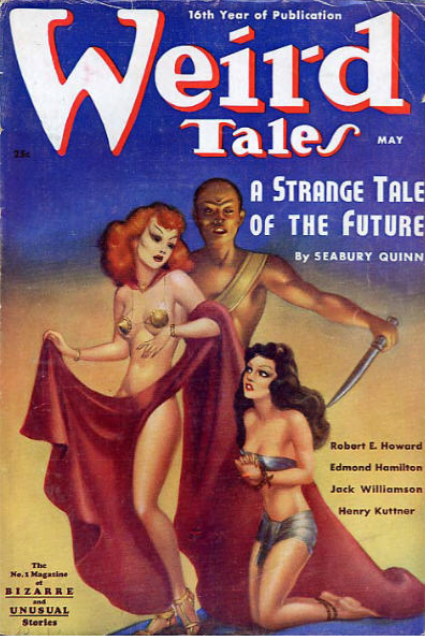Weird Tales magazine turned fifteen years old in March 1938. In the anniversary installment of "The Eyrie," from May 1938, the editor allowed readers to speak on the occasion:
Fifteenth Anniversary
Richard H. Jamison writes from Valley Park, Missouri: "Congrats on WEIRD's fifteenth anniversary! You really started something with that March 1923 issue, for with that issue the first (and best) of the fantastics was born. There's been a world of improvement in the lusty youngster since he first saw the light of day fifteen years ago.
The first issue had rough edges, no interior illustrations, and many of the stories were pure and simple detective stories. But now we have smooth edges, the best illustrated magazine on the market, and the stories are uniformly good weird tales with quite a number of little masterpieces among them. I noticed a letter in the Eyrie in which the writer asked who had written the most stories for WT. Seabury Quinn has that distinction, having contributed no less than ninety-two stories since his first appeared in October 1923. He has also had two stories reprinted. His closest competitor is August Derleth with sixty-nine stories, no reprints."
The author of that letter would appear to have been an early cataloguer of Weird Tales, its contents, and the authors who wrote for the magazine. Good for him. Seabury Quinn would remain the all-time champion with 145 stories and fourteen articles published in Weird Tales in its original run. And August Derleth would remain in second place. As for Richard H. Jamison, he was presumably the same man who wrote letters to "The Eyrie" as Richard F. Jamison. If that's the case, then he would also have landed on a list of "Who Wrote the Most . . .?", for Jamison had eleven letters in "The Eyrie" from January 1937 to March 1940, and that would have tied him with six others for eighteenth place on the list.
Letters to "The Eyrie," May 1938, continued:
Back in 1923
Arthur Lincoln Brown writes from Dallas: "For a number of years now I have been reluctant to write you this letter, but today it rived its fetters and escaped to you. Back in 1923, when your magazine first made its appearance on the news stands, it was primarily a magazine daring to open the way to the inexhaustible field of weird fiction. I have watched it grow, expand, and improve until now it has reached the acme of weird fiction. In my estimation, it is today at the pinnacle of success. WEIRD TALES is a piece of literary art founded on the genius of its authors--on the co-operation of its readers--on the receptiveness the editor holds for each new suggestion of improvement. Readers of fiction sometimes are fortunate to discover WEIRD TALES early; others must advance, explore and read their way through numerous cheap and pulpy magazines that litter the news stands before they discover WEIRD TALES. By this I mean that some of us have had to graduate to it before we became satisfied; but once we have perused our first copy we are enmeshed within its realm of weird narratives. It has finally reached the summit of weird fiction, and may we keep it always superb in its unequaled uniqueness."
(Boldface added in both letters.)
Unfortunately, I can't say for sure who Richard H. Jamison and Arthur Lincoln Brown were. But at least we have their thoughts from nearly ninety years ago.
Original text copyright 2024 Terence E. Hanley

No comments:
Post a Comment